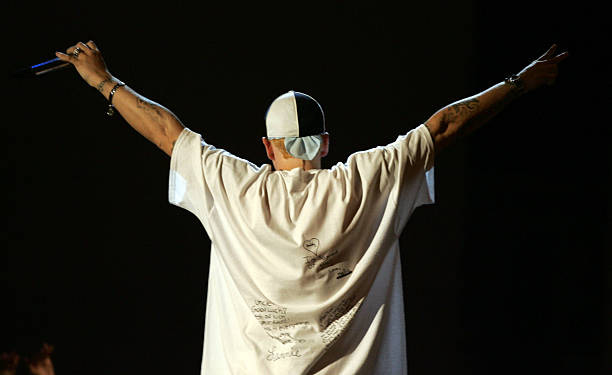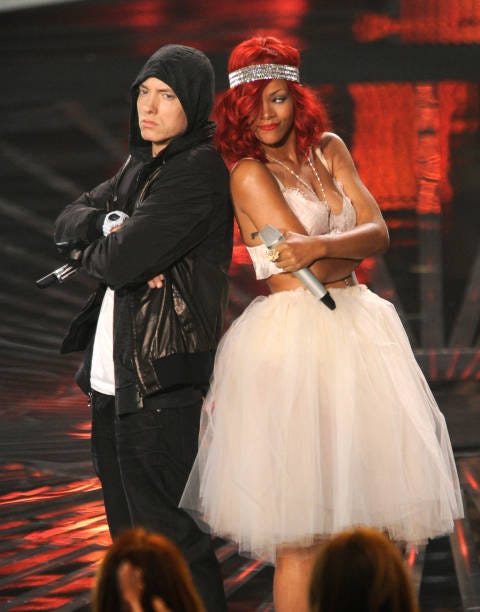Eminem: From Chaotic Rage to Eternal Witness
A CEM Analysis of the Expression of Eminem’s CEM Journey
A CEM Analysis of the Expression of Eminem’s CEM Journey**
Eminem: From Chaotic Rage to Eternal Witness
By Christina Fennell*
Eminem’s catalog is more than music, it’s a consciousness unfolding in real time.
Beneath the venomous wit and relentless rhyme schemes is a man who has been fighting to stay alive, be heard, and eventually, be experienced as whole in a world riveted by his fragmentation.
His early work exploded from the depths of reactive consciousness—raw, rebellious, and unfiltered. Through Slim Shady, he gave voice to the rage of the unheard and the fear of the unseen. His art was armor, and every verse a survival mechanism built from defense, defiance, and desperate humanness. But with time, the mask began to crack, the pain became harder to ignore, and the search for meaning grew louder than the desire to dominate.
Through grief, sobriety, and reflection, Eminem’s work began to soften without losing its edge. His lyrics turned from external attack to internal reckoning. His bars remained sharp, but now they cut into himself, revealing a man wrestling with guilt, fatherhood, legacy, and the question of what remains when the applause fades.
Today, Eminem raps less to prove and more to process. His presence feels steadier, his reflections deeper, and his insight sharper. He no longer clings to the mic like a lifeline, and so when he does speak, he speaks with precision, clarity, and power. His journey through consciousness isn’t polished or clean, it’s chaotic, brutal, and at times, profoundly honest. But in that honesty, he offers something rare: the map of a soul who didn’t just survive the fire, but learned to write in its ashes.
This is the story of a consciousness in motion, moving from reaction to reflection to creation as Eminem.
For the full Consciousness Evolution Model analysis, including a breakdown of each mode and how Eminem’s work may be programming collective perception, subscribe to the paid Substack and explore the journey beneath the persona.
How Consciousness Shapes Our Perception of Eminem
How we see Eminem says as much about us as it does about him. His work, often praised and condemned, has spanned nearly every human emotion and evolved across many realms of consciousness. For some, he’s a savior; for others, he’s a threat. Some hear pain; others hear poison. To some, he’s healing; to others, he’s a weapon. And as with any reflective artist, our reaction depends on the consciousness we bring to the experience. Whether we celebrate, judge, or misunderstand him is shaped by the inner stage we’re standing on when we press play.
Existence Stage – Survival Seeker
Fans at this stage are drawn to Eminem’s early work, especially The Slim Shady LP (1999) and The Marshall Mathers LP (2000) because it radiates raw survival energy. His aggression, humor, and shock value serve as catharsis for those navigating chaos and repression. He becomes a voice for the voiceless by mocking power, exposing pain, and refusing to be silenced. But fans here may reject his later work that demands reflection, seeing his emotional evolution as weakness or betrayal of the chaos they admired.
Attachment Stage – Belonging Seeker
Here, fans appreciate his desire for love, loyalty, and family, especially in songs like “Mockingbird” (2004) and “When I’m Gone” (2005). They resonate with his vulnerability, his ache for connection, and his attempts to repair relational wounds. But as he pulls away from needing approval, some fans in this stage may feel abandoned or critical of his sharper edges wanting him to stay soft, accessible, or emotionally available in the ways they found comforting.
Power Stage – Identity Builder
In this realm, Eminem is admired as the ultimate underdog-turned-dominator. His success story, lyrical precision, and unapologetic attitude in albums like The Eminem Show (2002) and Relapse (2009) inspire fans hungry to build their own power. But his later rejection of ego, fame, and status may be dismissed by fans in this mode who still equate strength with power. They may struggle to accept a version of Eminem who no longer wants to conquer, but simply create.
Compliant Stage – Image Restorer
Fans here resonate with Recovery (2010) and the narrative of public redemption. They find hope in his attempt to clean up his act, own his mistakes, and appear socially “safe.” But when he veers off-script, becomes politically vocal, or refuses to be palatable (Kamikaze, 2018), fans in this stage may turn critical because they are discomforted by his refusal to stay within the lines of rehabilitation and acceptability.
Performance Stage – Self-Fixer
At this stage, fans gravitate toward Eminem’s hyper-awareness and self-analysis. His confessional lyrics and disciplined sobriety model what it means to improve, evolve, and “do the work.” They value his control, clarity, and coherence, but they may reject his messier moments—like artistic risk-taking or expressions of lingering rage—as regressions rather than aspects of his whole self. The need for a “clean arc” can make them uncomfortable with unresolved truths.
Community Stage – Interdependent Seeker
Here, fans witness Eminem as someone offering lessons through transparency, not perfection. They understand that his presence—imperfect, evolving, and still searching—has value even without a triumphant ending. They’re less interested in persona and more invested in personhood. But fans in this mode may still project onto him the role of teacher, expecting continued growth or guidance that he may no longer wish to perform.
Authentic Stage – Truth Walker
Fans at this level respect his raw honesty, moral complexity, and refusal to be boxed in. They see beyond his provocations and into the psyche behind the sound. They don’t demand resolution and they welcome his paradoxical contradictions. But even here, some may unconsciously want to “fix” him or interpret his pain through their own lens of clarity, forgetting that authenticity doesn’t always come wrapped in wisdom.
Unity Stage – Wholeness Holder
In this rare stage, fans encounter Eminem not as an idol or icon, but as a mirror. They see the totality of his journey, both shadow and light, as sacred. They embrace his evolution, his missteps, his quiet moments, and his art as all part of a whole human being expressing themselves over the course of a lifetime. They expect nothing and receive everything. From this place, there is no rejection, only reflection. Eminem is no longer a performer to admire or critique. He is a fellow human being, walking his path, reminding us that every story, no matter how jagged, belongs.
Being Stage – Still Presence
At this stage, fans meet Eminem beyond his discography. His silence becomes as powerful as his lyrics. There’s no need for explanation, recovery, or clarity as his mere existence holds resonance. Fans here perceive the pauses, the disappearances, and the humanness behind the art not as voids, but as invitations. They no longer ask who he was or who he’s becoming, they simply hold space for who he is, without needing more. From this consciousness, stillness is sacred and the artist is no longer the product, but the presence.
Living Stage – Mutual Creation
In this expansive stage, Eminem becomes less of an influence and more of a collaborator in the inner world of the fan. His work becomes something to co-create with, reinterpret, and embody in alignment with one’s own path. He is no longer on a pedestal, rather he is in communion with all. Fans at this stage don’t idolize or critique him, rather they participate in continuous becoming. They meet his art not to consume it, but to alchemize it. From this consciousness, Eminem becomes part of a greater whole, an evolving imprint in the living field of human expression.
Author’s Reflection
Writing about Eminem feels daunting, not because the words aren’t there, but because his presence in my life has been so massively embedded in my emotional and energetic history, that capturing it feels like trying to bottle lightning that has already fried and then rewired my system.
I first heard “My Name Is” when I was around twelve years old and while I didn’t understand it or him at the time, I was one of many who thought “he’s so cute though.” It turned out that he was speaking from a place that I hadn’t yet touched in myself, but I watched as kids around me imitated him—bleached their hair, copied his clothes, embodied his persona with wild loyalty. It was jarring to see one person influence a generation like that and it was the first time I saw just how much power one voice could hold.
By high school, the gravity of his work started to hit me. I was beginning to awaken to my own voice and my own pain realizing just how tightly I’d been controlled by the people and systems that raised me. Rage started bubbling beneath the surface, but it didn’t yet have a name; however, it did have a sound, and that sound was his voice.
Eminem gave me an outlet to feel my anger without having to act it out. He gave me language for my own self-loathing before I could articulate what was happening inside me. Especially, the songs that reflected his shadow consciousness (his shame, his addiction, his violence, his hatred) those were the songs that I clung to the most. Not because I glorified them, but because they told the truth by mirroring back parts of me I was too afraid to name.
To me, Eminem is one of the most prolific shadow workers of our era. He holds up the mirror and dares people to look at themselves, at their pain, and at the dysfunction in their homes and their systems. Sometimes that mirror is cracked, sometimes it’s distorted, but it’s always revealing something raw and honest about what it means to be human. His music gave me permission to feel what I felt without shame, and that altered the course of my relationship with myself and others.
I’ve only seen him perform live once in 2014 during The Monster Tour with Rihanna. Being in the energy of his fans was unforgettable…and overwhelming. While I love and honor his work, I’ve never fully resonated with the culture around him, and that’s part of his brilliance. As a shadow worker, he activates not just what we embrace, but what we reject. He pulls forward the parts we disown and that tension is what I love most about him, because it’s shockingly pure medicine for a fragmented psyche.
He invites contradiction because he is a contradiction. And that contradiction has helped millions survive this devastating thing called life.
He is the Proof that a consciousness forged in hell can still become a light. Not a soft one, but one that blazes, scorches earth, and then rises from the ashes as naturally as breath brings clarity. He shows us the way through when everything in us wants to give up. He invites us to meet the monster within without flinching as he maps the darkness for our collective survival.
Em, there are no words to encapsulate your impact in my reality. You didn’t have to come here, you didn’t have to stay, you didn’t have to do any of this, and yet you did. You saw and you conquered. You bled and you died. You gave life and you paid respect. And through it all, you were honest. And I, I am eternally grateful to have been forged in the fires you set, seen in the pain you endured, and refined in the Truth you carry. Always.
In the end, Eminem doesn’t belong to any of us. But through the lens of our own consciousness, he becomes a reflection of what we’re ready to see, and what we still resist.
Let’s give Eminem his flowers.
Take a moment, reflect, and drop your answers in the comments.
How has your view of Eminem changed as you’ve evolved?
What has Eminem’s work meant to you over the years?
Which version of Eminem resonates with you most—and why?
Ready to explore your own consciousness journey?
If you’re curious about how the Consciousness Evolution Model applies to your life, relationships, and personal programming, schedule a 1:1 CEM analysis session with me. Together, we’ll map your unique path of evolution and uncover the patterns shaping your inner world. Book your session at intentionalhumaning.com and begin the journey of remembering yourself whole.
All images from IMDB.com (unless otherwise noted).
*This post was created in collaboration with AI to organize, clarify, and refine the thoughts of the author.
**This is a consciousness analysis of a public figure’s artistic expression—not their private life or inner world. I do not claim to know who this person is beyond what they have publicly shared. My intention in this series is to explore how consciousness expresses itself through public art, interviews, and creative work using the Consciousness Evolution Model (CEM). This is about decoding the energetic and psychological patterns embedded in the art we consume. May this lens help you engage with art, media, and self-expression in a more conscious, empowered, and sovereign way.













So freaking good!